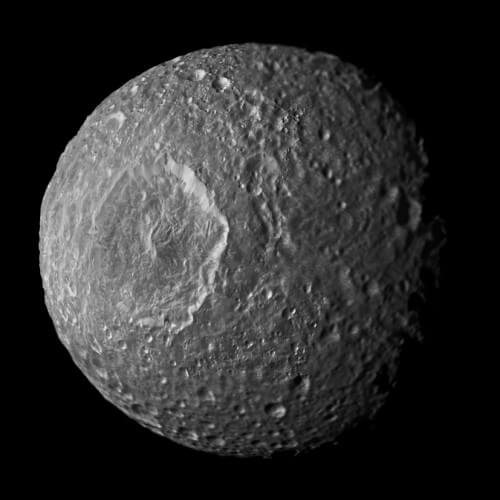A new study focuses on the interior of Saturn's icy moon Mimas, and suggests that its scarred surface hides one of two possible types of interior: a football-shaped icy core or an ocean of flowing water.

A new study focuses on the interior of Saturn's icy moon Mimas, and suggests that its scarred surface hides one of two possible types of interior: a football-shaped icy core or an ocean of flowing water.
The researchers used many images of Mimas taken by the Cassini spacecraft to determine the rate of wobble of Mimas as it orbits Saturn. They then evaluated several possible models for its internal composition, and discovered two possibilities that fit the data. The study was published on October 17, 2014 in the journal "Science".
"According to the data, something is wrong inside Mimas," says Radwan Tajdin, from the Cassini project at Cornell University in Ithaca, New York and the lead researcher of the paper, "the amount of oscillations we measured is double what we observed."
Either option is interesting, Tajdin says. The scarred face of the moon does not betray what lies beneath the surface. Since Mimas was formed over four million years ago, scientists estimate that its core cooled and turned into a snowball. If the core is still elongated, this records a stage in the formation of mimas frozen in time.
If Mimas has an underground ocean, it joins the prestigious club of "ocean worlds," which includes some of the moons of
Jupiter and two of Saturn's other moons - Enceladus and Titan. "The existence of such an ocean would be a surprise," Tajdin says, "because the surface of Mimas does not reveal any sign of geological activity."
Like many moons in the solar system, including our own, Mimas shows one side of its face to the planet it orbits. This process is called spin-orbit resonance and it means that the rotational movement of the body is synchronized with its orbit around Saturn. Like the Earth's moon, Mimas takes the same time to complete a complete orbit around Saturn and to rotate on its axis.
The route of Mimas is a bit stretched and not a perfect circle. These changes in distance cause the point on the surface of Mimas facing Saturn to change from lap to lap. An observer from Saturn will see Mimas wobble during its orbit, allowing a small area of land beyond the rim to be seen. This phenomenon is called liberation, and our moon also exhibits it.
"Watching libation can provide important insights into what's going on inside the body." Says Tajdin, "In this case, it tells us that this small, crushed moon is much more complex than we thought."
According to the model developed by Tajdin and his colleagues, if Mimas has an underground ocean, it is at a depth of 24-31 km below the surface. Since the width of Mimas is 396 km, it is too small to preserve the internal heat that prevailed when it was formed, so an energy source is needed to preserve the underground ocean. The researchers commented that there is evidence that Mimas' elongated 'current' orbit was even more stretched in the past, which may have created tidal waves that formed the ocean.
Although the discovery of an ocean inside Mimas would be a surprise, the researchers found that the internal composition model is consistent with Mimas' core being elongated. This means that other models need to be developed to explain the observed liberation of Mimas, and that more Cassini measurements are needed to help determine which model is the most likely.
For information on the NASA website
More of the topic in Hayadan:

4 תגובות
Old newspaper readers, please respond. All those who put pepper on the site and slander and insult.
Another example of NASA's tremendous capabilities shrunk to telescope observations and rare: unmanned landings on other planets.
Football-shaped core: meaning American football, elongated. This is also explained in the article. An elongated core, unevenly deviated from the center of gravity, may affect the moon's oscillations. What is obvious in the English original is lost in the Hebrew translation. Perhaps you could write in the subtitle "elongated core" instead of "football-shaped core".